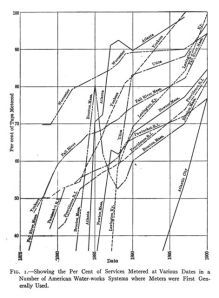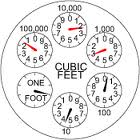I am not talking about the California Community Foundation, Cheetah Conservation Fund or Center for Children and Families. Hey, I write about water stuff.
A few thousand water utility employees and I know what CCF means, but the overwhelming majority of people who pay water bills in the U.S. have no idea. Let’s try an experiment. Pull out your last water bill (its buried in the to-be-paid pile somewhere). Look at the amount of water your household used in the last billing period (usually one or two months). Ah ha! It says that you used 7.2 or 10.4 or 22.6 CCF. Well, that doesn’t sound like much. (Some water bills convert your usage in CCF to gallons and even graph the last 12 months, which is helpful.)
Ok. I will clear up the frustration for you. CCF means hundreds of cubic feet. The “C” stands for centum. Is this ringing a bell? When you represent numbers as Roman numerals, “C” stands for…wait for the drum roll…one hundred! Hold on a minute, you say, I am being billed for water in Latin? Yep.
Actually CCF represents a combination of the Latin language and an English unit of measurement. I didn’t clear up your confusion did I? You must be asking, what genius started using this mosh pit of water usage?
A few days ago, I got involved in a Twitter exchange with @PeterGleick, @jfleck and @cfishman who expressed some confusion about the meaning of CCF. Actually, Peter knew what it meant but the other two guys who write about water for a living did not. If these guys are confused, how can a typical water-bill-payer know what is going on? How did we get in this mess?
It’s all about water metering. While individual meters were relatively expensive back then, the impetus to install them came from the huge amount of water waste that occurred when flat-rate charges were used. For example, you might be charged for water service based on the number of fireplaces you had. There was no incentive to conserve water so people would leave their taps on during the winter to prevent the pipes from freezing and bursting.
When a new centralized water supply system was installed in a city in the 1800s, everyone was thrilled. However, metering was not usually done in the beginning and the public became used to wasting water because there were no penalties. A crisis would be reached when it became necessary to expand the water system or seek a new supply because the original one that was supposed to last many decades was overtaxed. There are many articles in the early literature that emphasized water conservation (usually involving metering) instead of the huge capital investments to develop a new water supply and build a larger treatment plant.
 One source stated that water meters became available as early as the 1850s in the US. Allen Hazen (usually known for his work in filtration) wrote a book about metering in which he stated that the earliest reliable meters were available in the 1870s. The early meters measured water use in either gallons or cubic feet. The attached graphic shows that metering for cities such as Fall River, MA; Yonkers, NY; Pawtucket, RI and Worcester, MA occurred during the late 1870s.
One source stated that water meters became available as early as the 1850s in the US. Allen Hazen (usually known for his work in filtration) wrote a book about metering in which he stated that the earliest reliable meters were available in the 1870s. The early meters measured water use in either gallons or cubic feet. The attached graphic shows that metering for cities such as Fall River, MA; Yonkers, NY; Pawtucket, RI and Worcester, MA occurred during the late 1870s.
Measuring water use in gallons made sense of course, because everyone used that unit of measure for volume for a variety of liquids. The use of cubic feet to measure volume of water use is a little more obscure. Flow measurement in cubic feet per second has been a standard for centuries. An early mention of water usage being measured in cubic feet was in a letter to a customer that was printed in the September 1889 issue of the JNEWWA. Another early mention was in one-page article published in 1892 which related one water professional’s experience with a home water meter.
I suspect that cubic feet might have been preferred by some early meter manufacturers because it was a larger volume than gallons (each cubic foot is equivalent to 7.48 gallons) and the meters were notoriously inaccurate and imprecise. An error of a few cubic feet was not as big a deal as an error of dozens of gallons.
Allen Hazen was clearly frustrated with the dual reporting units for water use. In 1916, at a meeting of the Committee on Meter Rates for the New England Water Works Association, he requested a vote of the committee members present on which unit of measure should be used. The final tally was 17 in favor of cubic feet and 23 members who wanted to use gallons.
It is worth quoting a 1916 letter that Walter P. Schwabe sent to the NEWWA committee on meter rates that exemplified the reasons why gallons should be used. Many of the reasons are as true today as they were 97 years ago.
“I am convinced from experience that gallons in dealing with the consumer is the better unit to use. I find it much easier to talk with a customer on his water consumption in gallons than in cubic feet, and find the customers have greater confidence in meters and in our statements, as they can readily check up their meter readings and make tests themselves.
The public buys all liquid commodities by the gallon unit….Pumps, standpipes, etc., are all rated on gallon capacity…”
There is some evidence that the cubic foot was used by many utilities to keep the measuring and billing processes mysterious. Continuing to quote from Mr. Schwabe’s letter:
“The argument that commodities, such as gas and electricity, are measured in units that are foreign and not understood by the layman is no excuse for using such a unit (cubic feet) for the measurement of water when there is a better and commonly understood unit (gallons) that can be used.”
As noted in a recent Wikipedia article, natural gas is commonly sold in units of 100 cubic feet.
In a book published in 1906, rates using 100 cubic feet as the measure of water volume were explicitly listed. For the first 5,000 cubic feet, the rate for six months was $0.20 per 100 cu. ft.
In his book published in 1918, Allen Hazen stated the problem and his preference.
“Water is sold at meter rates either by the 100 (or 1000) cubic feet or by the 1000 U.S. gallons. Both units are in common use. In the early days of metering, the use of cubic feet predominated, and it seemed at one time as if this unit might be universally adopted. Recently, however, there has been a tendency to go back to the gallon.”
 The real problem with changing over completely to gallons and not mentioning cubic feet at all is that many of the meters in people’s homes register in cubic feet. The analog meters with multiple dials (see accompanying image) are really confusing. If you take a close look at the face of the meter, some of the dials spin clockwise and other spin counter-clockwise. A whole bunch of trees have been killed printing brochures on how to read these complex analog readouts. Many customers want to match up what they are being billed for with what they can read for themselves. It would not work to bill in gallons but only have meters that register in cubic feet.
The real problem with changing over completely to gallons and not mentioning cubic feet at all is that many of the meters in people’s homes register in cubic feet. The analog meters with multiple dials (see accompanying image) are really confusing. If you take a close look at the face of the meter, some of the dials spin clockwise and other spin counter-clockwise. A whole bunch of trees have been killed printing brochures on how to read these complex analog readouts. Many customers want to match up what they are being billed for with what they can read for themselves. It would not work to bill in gallons but only have meters that register in cubic feet.
Some of these problems may be solved with the conversion from analog water meters to digital water meters that are read remotely. However, the local readout may be still be in gallons or cubic feet. Also, water rates have historically been in cubic feet for many utilities and minimum usage amounts can also be in this archaic terminology.
Why is any of this important? Water conservation has become a critical part of the water resources planning for U.S. water utilities. In other words, utilities are counting on a certain level of conservation in the future so that they do not have to build additional water supplies as the population grows. We should make it as easy as possible for the public to monitor their water use and adopt units that mean something to them so that conservation is encouraged. I doubt if saving one CCF is going to have a great impact on a household’s consciousness. Saving 14-55 gallon drums of water may make a bigger impression and encourage conservation.
To promote conservation, water utilities should make every effort to use gallons in their rate structures, meters, and bills. CCF should be relegated to the same historical dustbin that contains the velocity measurement of furlongs per fortnight.
Of course, maybe this is all moot since we will soon adopt the metric system for all our measurements and water will be measured and billed in cubic meters…. I wish. I am afraid this will not occur in my lifetime.
References:
Hazen, A. Meter Rates for Water Works. New York:John Wiley & Sons. 1918. 12.
“Report of Committee on Meter Rates.” Journal New England Water Works Association, 30:3 September 1916. 396-7.
Letter. Journal New England Water Works Association, 4:1 September 1889. 46.
Taylor, L.A. “An Experience with a Water-Meter.” Journal New England Water Works Association, 6:4 June 1892. 182.
Turneaure, F.E. and H.L. Russell. Public Water-Supplies. New York:John Wiley & Sons. 1906. 731.





For hottest news you have to pay a visit interet and on web I found
this web page as a most excellent website for hottest updates.
I really enjoyed your post! As an engineer trying to help my local park department understand it’s water use city wide, 7.48 is my favorite number. Nerd humor!
thanks for the input! simplified explanation on complex things like this eased the lives of ordinary people likeme…. more power!!!